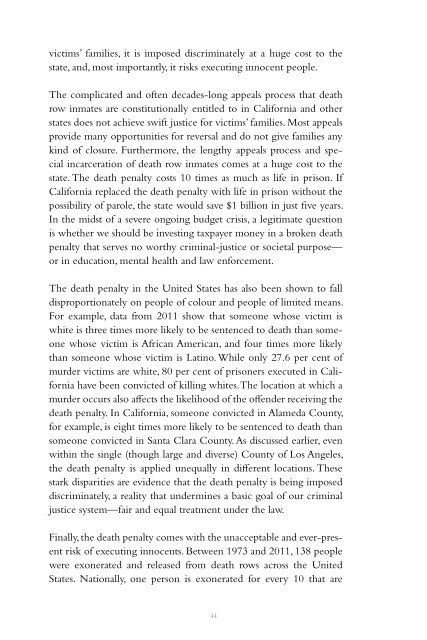PENALTY
DBk0302s7Xm
DBk0302s7Xm
You also want an ePaper? Increase the reach of your titles
YUMPU automatically turns print PDFs into web optimized ePapers that Google loves.
victims’ families, it is imposed discriminately at a huge cost to the<br />
state, and, most importantly, it risks executing innocent people.<br />
The complicated and often decades-long appeals process that death<br />
row inmates are constitutionally entitled to in California and other<br />
states does not achieve swift justice for victims’ families. Most appeals<br />
provide many opportunities for reversal and do not give families any<br />
kind of closure. Furthermore, the lengthy appeals process and special<br />
incarceration of death row inmates comes at a huge cost to the<br />
state. The death penalty costs 10 times as much as life in prison. If<br />
California replaced the death penalty with life in prison without the<br />
possibility of parole, the state would save $1 billion in just five years.<br />
In the midst of a severe ongoing budget crisis, a legitimate question<br />
is whether we should be investing taxpayer money in a broken death<br />
penalty that serves no worthy criminal-justice or societal purpose—<br />
or in education, mental health and law enforcement.<br />
The death penalty in the United States has also been shown to fall<br />
disproportionately on people of colour and people of limited means.<br />
For example, data from 2011 show that someone whose victim is<br />
white is three times more likely to be sentenced to death than someone<br />
whose victim is African American, and four times more likely<br />
than someone whose victim is Latino. While only 27.6 per cent of<br />
murder victims are white, 80 per cent of prisoners executed in California<br />
have been convicted of killing whites. The location at which a<br />
murder occurs also affects the likelihood of the offender receiving the<br />
death penalty. In California, someone convicted in Alameda County,<br />
for example, is eight times more likely to be sentenced to death than<br />
someone convicted in Santa Clara County. As discussed earlier, even<br />
within the single (though large and diverse) County of Los Angeles,<br />
the death penalty is applied unequally in different locations. These<br />
stark disparities are evidence that the death penalty is being imposed<br />
discriminately, a reality that undermines a basic goal of our criminal<br />
justice system—fair and equal treatment under the law.<br />
Finally, the death penalty comes with the unacceptable and ever-present<br />
risk of executing innocents. Between 1973 and 2011, 138 people<br />
were exonerated and released from death rows across the United<br />
States. Nationally, one person is exonerated for every 10 that are<br />
executed. The factors that commonly lead to wrongful convictions<br />
are rampant and varied: eyewitness error, false confessions, false testimony<br />
by an informant, prosecutorial misconduct and poor forensic<br />
evidence. The risk of wrongful conviction and execution can never<br />
be removed from a death penalty system.<br />
In November 2012, California voters had the opportunity to replace<br />
the death penalty with life in prison without the possibility of parole<br />
through a voter initiative known as Proposition 34. While that proposition<br />
lost, the trend in public opinion had clearly changed. In 1978,<br />
Californians had voted overwhelmingly (70 per cent to 30 per cent)<br />
to reinstate the death penalty. But in 2012, 48 per cent of Californians<br />
voted in favour of repeal while 52 per cent voted against it (5,974,000<br />
to 6,460,000). If about 250,000 voters had had been convinced to<br />
change their votes, there would be no death penalty in California<br />
today. The initiative failed in good part because the campaign did not<br />
reach enough voters with information. The reality of the California<br />
political system is that winning a ballot initiative, especially on a<br />
controversial issue like the death penalty, requires millions of dollars<br />
for voter education; unfortunately, the repeal campaign did not have<br />
sufficient resources.<br />
Since Prop 34’s defeat in 2012, California’s death penalty repeal advocates<br />
are continuing to educate the public about the high costs of the<br />
death penalty; reshaping the California Coalition behind Proposition<br />
34 into an ongoing advocacy campaign to promote public safety policies<br />
that reflect our shared values of safety, accountability, fairness and<br />
equality; and strengthening alliances with law enforcement, victims<br />
and labour as well as traditional supporters in the faith and civil rights<br />
communities. The ultimate goal, replacing the death penalty with life<br />
in prison without the possibility of parole, will best serve our priorities:<br />
to protect law-abiding citizens and punish those who commit<br />
society’s most heinous crimes.<br />
FEDERAL DEATH <strong>PENALTY</strong> CASES<br />
The vast majority of death penalty cases are handled in the state<br />
courts. According to the Federal Death Penalty Resource Project,<br />
federal prosecutors tried 190 death penalty cases, involving 281<br />
44 45


